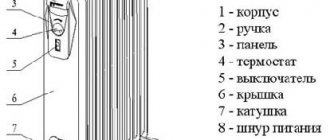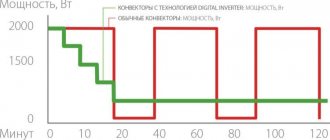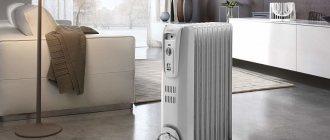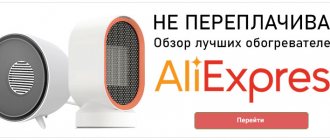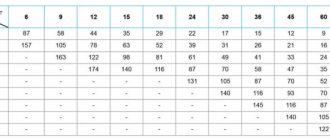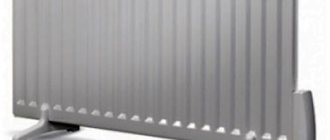Low coolant temperature, severe weather conditions, lack of heat supply before the start of the heating season: there are many reasons why there is a need for individual heating using an electric heater. A convector is used for this, but the consumer has a natural and understandable question: how much electricity does he consume? The answer to the question will not be clear. No one can state the final number with confidence, since there are too many factors influencing the numbers. The number of kilowatts spent will depend on the operating intervals of the device. Let's try to figure out how much a convector consumes on average, what factors influence the numbers, and how to minimize consumption.
Consumption
The amount of electricity consumed is influenced by the following aspects:
- The degree of thermal insulation of the room where the device operates.
- The size of the room, the location of the convector, the correct selection of the device.
- Possibility of arranging automatic control of the desired room temperature.
- Temperatures outside.
- Convector power consumption.
It will not be possible to predict the final kilowatt-hour figures for the reporting period with an accuracy of units, but it is quite possible to make an approximate calculation and answer on average how much electricity convectors consume.
Before calculating the electricity consumption of a convector, you need to calculate the amount of electricity consumption by other household appliances. All equipment that requires a constant supply of voltage to function consumes energy according to its power. Information about this is indicated in the passport of any device.
The calculation is different for each household appliance, since they have their own specific operation.
For example, a single-burner heating element stove has a power of 2000 watts and worked for ten minutes. First, we calculate how much was consumed per minute; for this we divide two thousand watts by sixty minutes. We get 33, 33 watts. We multiply this amount by ten minutes of work and get just over 333 watts.
Calculation of electricity consumption by a convector looks somewhat different. First set the desired air temperature. If the heater power is two thousand watts, then the device will work at full capacity until the required temperature is reached. When the desired air temperature is reached, the temperature control system will work and the supply of electricity to the device will temporarily stop. Subsequent activation will occur when the temperature drops below the programmed one. Having raised the temperature to the required one, the convector will stop working again. A specific operating mode in the form of periodic on-off switching is inherent in the heater (convector). If the equipment has a power of two thousand watts, then in sixty seconds of operation it consumes 33.33 watts. To find out the number of watts consumed over the entire period of operation, you need to perform simple arithmetic and multiply the consumption per minute by the amount of time that the heater worked. The duration of work and the rest period will vary in each specific case, since there are many external factors that influence this. When choosing climate control equipment, it is necessary to take into account that electric convectors have their own characteristics.

Convector mounted on a vertical plane
They differ in the following parameters:
- type of fastening;
- a type of heating element.
All heaters operating by air convection type are combined into three main categories:
- Mounted on a vertical plane. Wall heaters are recognized as the most efficient. The vertical arrangement optimizes the heat distribution process, increases the efficiency and productivity of the heater.
- Installed on a horizontal surface. Higher performance of models with built-in fan. Used as an additional heat source. Due to artificial air circulation using a fan, the operation of the convector is characterized by the presence of extraneous noise, but is characterized by high heat transfer.
- Universal models that can be easily installed on any surface. Equipped with an additional mount for hanging on the wall and wheels for simple and easy movement on the floor.
The energy of an electric type convector depends on the type of heating element used. Currently, three options are used, each option has its own impact on the operational capabilities of the heater.

Convector mounted on a horizontal surface
Needle, tubular and monolithic heating elements are used. Needle heating elements are used in budget models and are not protected from water, moisture, or condensation. A tubular heating element often operates with extraneous sounds (“crackling of firewood,” hissing), and the device also takes a very long time to warm up. Monolithic heating element is considered the most economical, operates silently, quickly and efficiently heats the room.
Electricity consumption
An issue that worries everyone who uses a heater, especially on an ongoing basis, is the electricity consumption of convectors. To simplify the calculation of electricity consumption, let’s take a room of forty square meters as an example.
- The total power of convectors for such a room is four thousand watts.
- The heater does not operate continuously, but switches off periodically when the set temperature is reached. In this mode, electricity consumption per day has a coefficient of about sixty percent.
- Calculating electricity costs involves the following steps: 4000 divided by sixty percent. This equals 6.7 kW per hour.
- Calculating electricity consumption per day with an electronic thermostat is not difficult. On average, the operating time of the convector per day will not exceed twelve hours. We multiply 12 hours by 6.7 kW - we get 80.4 kW per day.
- The convector will consume 2412 kW per month. We multiply 80.4 kW by thirty - the average number of days in a month.
Let us make a reservation that the obtained result will be different in different rooms, since the indicators are influenced by the type of convector, the degree of insulation of the room, the probability of heat loss and other parameters.
User reviews and observations have shown that a convector is an excellent option for climate control equipment for heating. It is safe, has high protection against fire, and does not have a negative effect on the body.
Here you will learn:
Electric convectors are quite common devices. They are characterized by high efficiency and miniature size, making it possible to heat rooms for various purposes. When using electric convectors to heat a private home, the price of heating can be quite high . Is it worth using this heating equipment at all and how justified is it when heating private households?
In our review article we will cover:
- about the costs of electric heating using electric convector heaters;
- on calculating the number and power of convectors for a particular area;
- about the choice of electric convectors and adjustment of heating costs.
After reading this material, you will get an idea of the feasibility of operating electric heating using convector heaters.
Economic benefits from using electric convectors
Using electric convectors to heat a private home, the price of heating will consist of the initial costs of purchasing the equipment and the cost of electricity required to operate the equipment. Can electric heating be called profitable? When compared with classic heating systems with electric boilers, radiators and pipes connecting it all, the benefits are obvious:
- no need to buy an expensive boiler;
- no need to buy temperature control equipment;
- there is no need to buy and lay pipes.

By choosing heating with such devices, you save yourself from purchasing all this expensive equipment and laying pipes.
We calculate the number of convectors
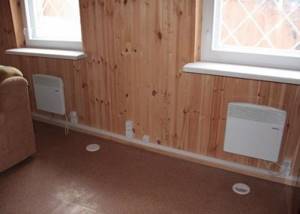
By placing appliances under windows, you prevent cold air from entering from them.
Are you planning to buy convectors for heating your home, but can’t figure out how many there are? In many cases, one heater is enough to heat one room. For example, for a room of 15 square meters. m in a well-insulated house, you should purchase a model with a power of 1000 W (as manufacturers advise, but we remember the need for a reserve and the climatic conditions of our country). Therefore, the recommended power will be 1500 W.
The optimal place to place a convector is under a window from which the cold comes . In order to protect yourself from the cold, we place devices under the windows. Accordingly, if there are three windows in a given room, we hang a heating device under each. In total, we will need three electric convectors with a power of 500 W each. The area of the room is 25 square meters. m, but it only has two windows? In this case, two convectors with a power of 1 and 1.5 kW are required.
Convector heating pros and cons
One of the main questions of interest to our readers remains the aspect of the feasibility of the purchase. Why a convector, and not an oil radiator, for example? What power characteristics should an electric convector have? How to choose the best one among the incredible assortment?
From a certain point of view, any equipment must contain pros and cons; an electric convector is no exception. We will start by listing the positive qualities, especially since they many times exceed the disadvantages of an electric convector.
1. We consider the main advantage to be a technological breakthrough that allows us to design an electric convector with an efficiency of 95%. Agree, paying for electricity and getting zilch as a result would be an unaffordable luxury. A modern convector converts electrical energy into heat with maximum efficiency.
2. The low price for an average 1000 W electric convector is a strong argument in favor of the purchase.
3. Quiet operation. An electric convector does not require a fan or any other mechanically moving structural elements. Silent operation is periodically interrupted by a barely audible click of the temperature sensor, which contributes to more economical operation of the device.
4. Lack of installation and maintenance work. An electric convector is considered a household appliance, connects to a 220-volt network and does not require permits from government organizations. The small mass of the convector is an additional plus when it comes to relocating the device in a heated room
5. Built-in automation helps maintain the required temperature in the heated room. Remote temperature sensors, made like sockets with a thermostat, additionally provide temperature control.
6. The heating element of an electric convector reaches the set temperature in a couple of minutes, starting to heat the room immediately after switching on. The element temperature, as a rule, does not exceed 60 °C, preventing heating elements from “drying” the air and “burning” oxygen. The absolute humidity of the air in the room does not change. As the temperature rises, only the relative humidity decreases slightly.
7. Low heating temperature of facing surfaces provides a safe environment for people and animals. In addition, you don’t have to worry about fire safety.
8. The service life of convectors declared by a number of manufacturers exceeds 20 years.
Electric heating convector probably has one drawback
So you bought a convector and made sure that your wiring can withstand the additional load. The device, connected to the network, instantly begins to heat the room. As they say, there would be no price for an electric convector if not for one BUT. The only negative, as you might have guessed, is the high cost of electricity consumed. But firstly, as we noted at the beginning of the review, the convector heats our apartment only during the off-season, and not throughout the winter.
Secondly, you need to choose electric heating convectors with a thermostat, then the built-in thermostat will not allow the device to “wind the meter” around the clock. Thirdly, care should be taken to preserve heat and, if possible, reduce heat loss; it is necessary to install double-glazed windows and take care of other insulation elements.
Another disadvantage is the smell of combustion; in fact, it is not oxygen that “burns”, but the dust that has settled on the electric heating element. To remove this drawback is as easy as shelling pears, either vacuum the convector, or simply wait until the dust completely burns out.

We calculate energy costs
Now we will try to calculate the power of the equipment necessary to heat the rooms. In our calculations we will use the standard formula, based on which for heating 1 sq. m we need 100 W of thermal energy . In the northern regions, this figure increases to 150 W, and in the southern regions it drops to 80 (it is best to focus on 100 W or check this figure with heating specialists in your region).

Remember a simple rule for calculating the power of a convector: multiplying the area of the room by 100 you get the power required for heating it in W.
Let's say we need to heat a house measuring 50 square meters. m of living space. For this we will need electric convectors with a total power of 5 kW. If the devices operate around the clock, the daily consumption will be 120 kW. Based on the average cost of 1 kW of energy at 4 rubles (different in different regions), daily costs will be 480 rubles, and monthly costs will be 14,880 rubles (for months with 31 days).
But convectors do not operate around the clock - they periodically turn on and off, maintaining the set temperature . Therefore, we can safely reduce the amount received by half - it will be 7,440 rubles. You also need to take into account that winters can be warm, with a large number of days with positive temperatures. In this case, heating costs will be lower. Electronic control, which provides more accurate support for the set temperature, will also help reduce costs.
What parameters affect energy consumption
The main criterion that determines electricity consumption is its heater power. The larger and colder the room, the more powerful the heating device is needed. Heat loss in the room is the main parameter for choosing a heating device.

We are talking about how much heat leaves the room through walls and windows. And through the ceiling or floor on the top or first floor. The heating device is designed to compensate for heat loss. Therefore, the thicker and insulated the walls and windows, the less power consumption of the heating device should be. The temperature outside is also important. The lower the ambient temperature, the greater the heat loss will be.
However, modern, more technologically advanced devices can consume less electricity for the same power. Of course, such models are often initially more expensive than their competitors, but they boast compact sizes and lower electricity consumption per month.
The power of heating devices is measured in kW/h. If the declared power of the device is 2 kW/h, this means that for 1 hour of operation it will consume about two kilowatts of energy. The cost of electricity depends on the region, and varies from 1.17 rubles per kilowatt in Irkutsk, and up to 5.66 rubles per kilowatt in Moscow. But the national average is about 4 – 4.5 rubles per kilowatt. For example, let's take Voronezh with the cost of electricity 4.04 per kW. It turns out that for 1 hour of operation of a heater with a capacity of 2 kW/h, a resident of Voronezh will pay 8.08 rubles.
Which convector to choose for a private home
- on equipment power;
- on the brand;
- on the type of control;
- for additional functions;
- for design features.
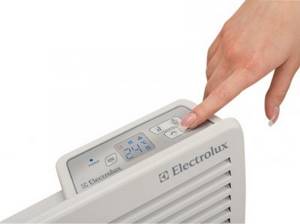
Electronic control of the connector will also help you save money, and the remote control will add ease of use.
We have already talked about equipment power and reducing heat losses. As for brands, we recommend buying products from well-known brands - it’s better to overpay a little than to suffer from constantly breaking convectors from little-known manufacturers .
It is also advisable to choose electric convectors with electronic control. Mechanical control is not particularly accurate, which entails additional heating costs. As for the electronics, it ensures compliance with the specified temperature conditions with an accuracy of 0.5 degrees. Thanks to this, energy costs will be reduced.
Additional functions include timers, remote controls, a built-in humidifier, work according to a given program, and much more. All these options slightly increase the cost of the equipment, but provide comfort during its operation. If you plan to heat a country home, we recommend that you pay attention to the presence of frost protection - this function will save energy on days when you are not at home (for example, you live outside the city only on weekends).
What is a convector?
The market offers a variety of types, where it is quite easy to get confused. Oil radiator, electric convector, infrared emitters, your head is spinning from the range and price offers. We will devote our review to the electric convector. The principle of operation of the convector is based on the physical properties of heat transfer from the coolant, in our case from the heating element to the heated room using internal energy, which is transmitted by jets and flows, that is, by convection.
In simple words, a heating element is built into the convector, which makes the air around it hot. The heated air begins to move upward, making room for cold air flows. This “cycle” is called natural convection. We hope we have answered the question of what a convector is. A picture will help you understand this simple process more clearly:

Operating principle of an electric convector
As we can see, the electric convector has a simple principle of operation. By the way, since air movement occurs due to convection, the device does not require additional equipment with a fan, thus the electric convector earns a plus in its piggy bank. Of course, this is not the only advantage that forces us to choose an electric heating convector to ensure a comfortable climate in our apartment, but first things first.
